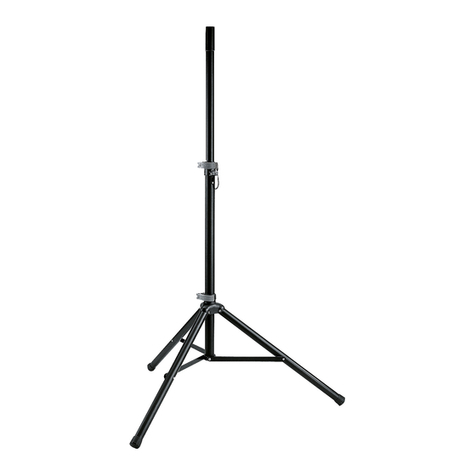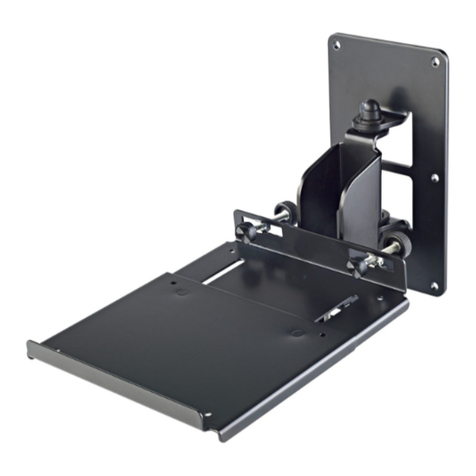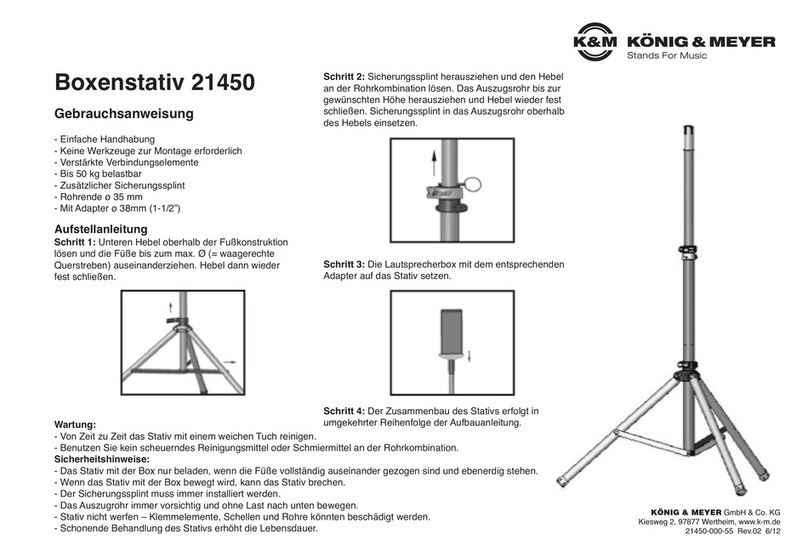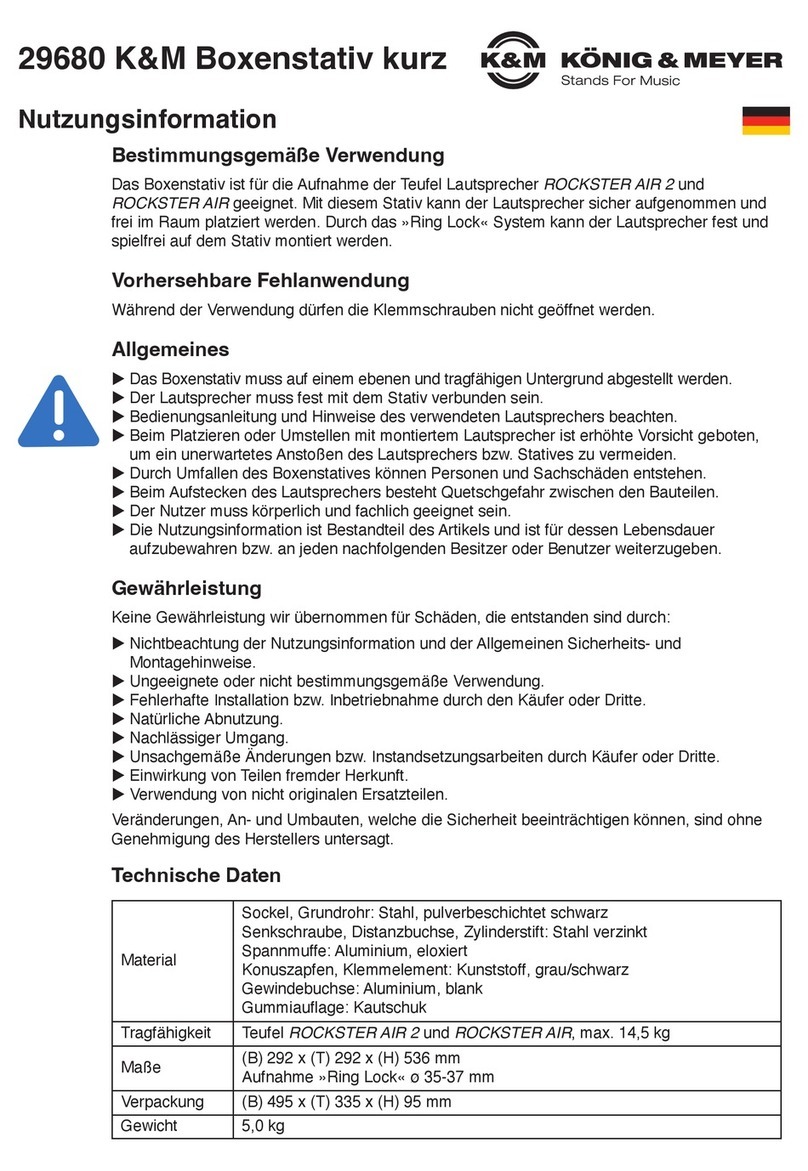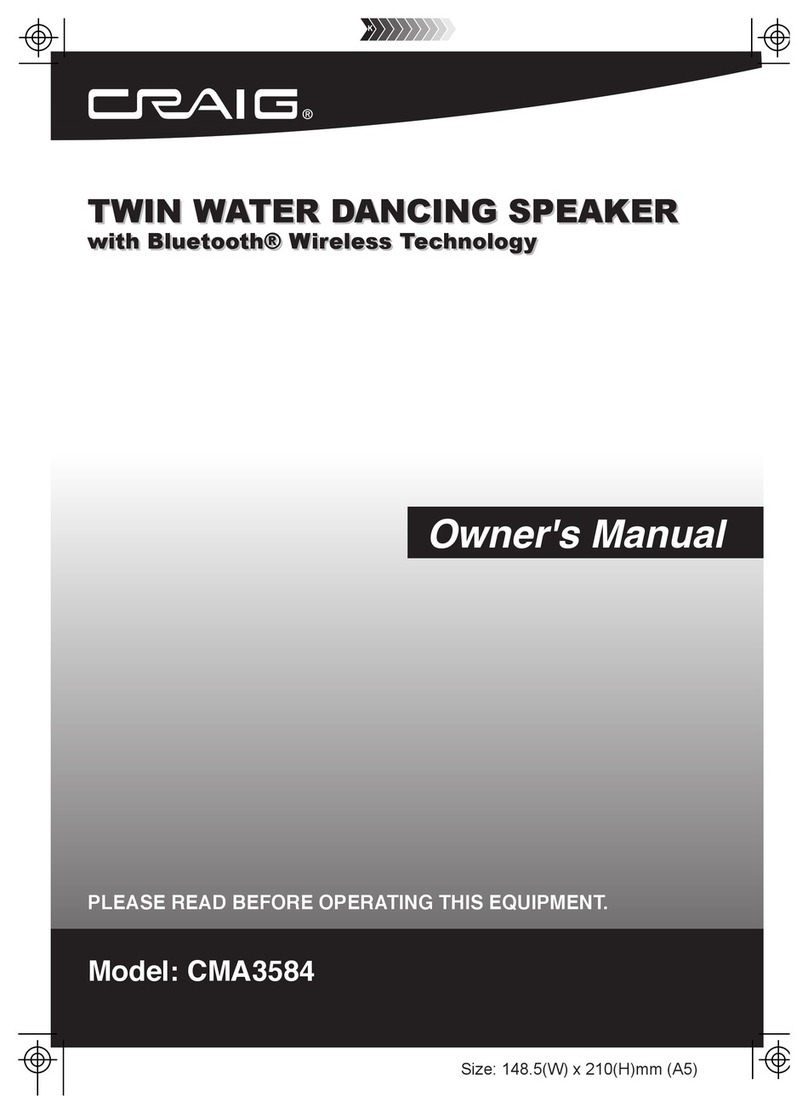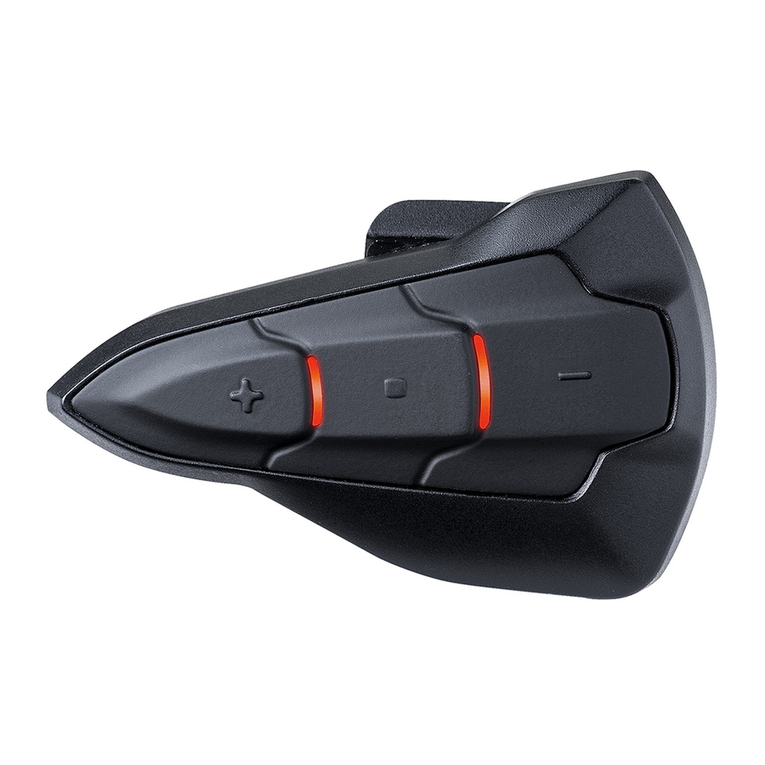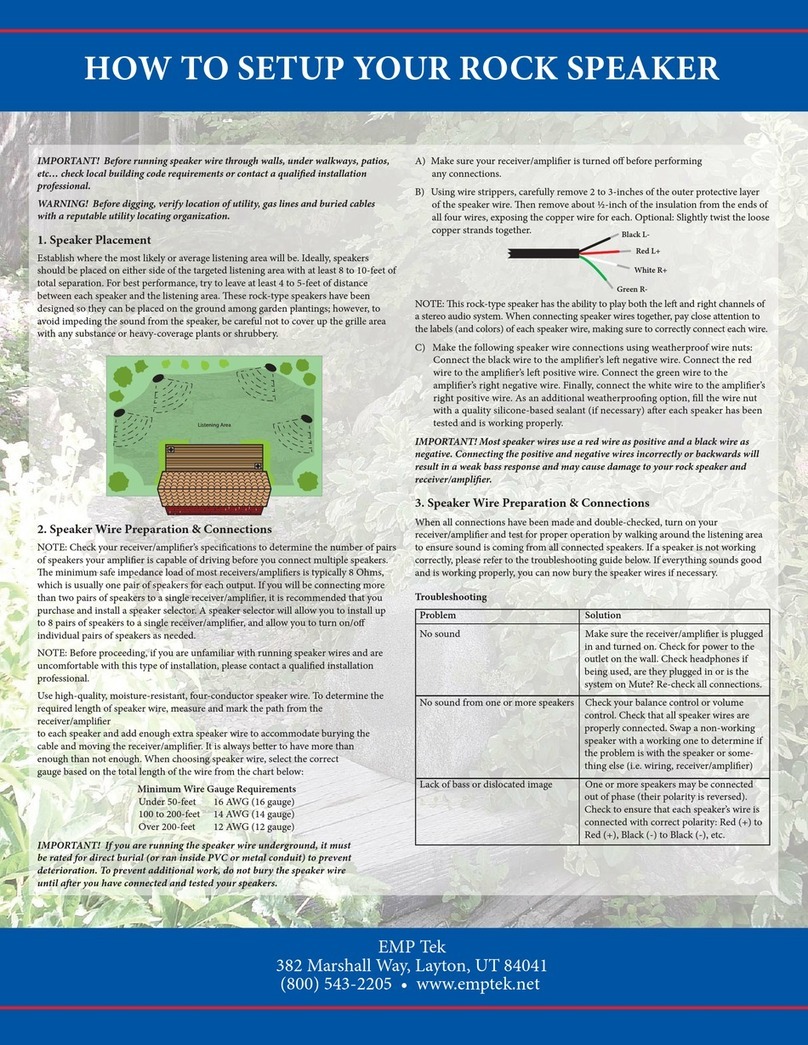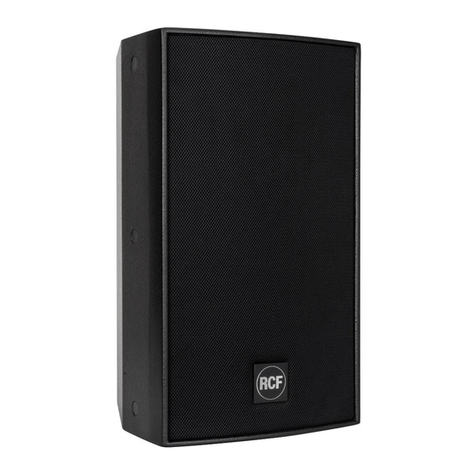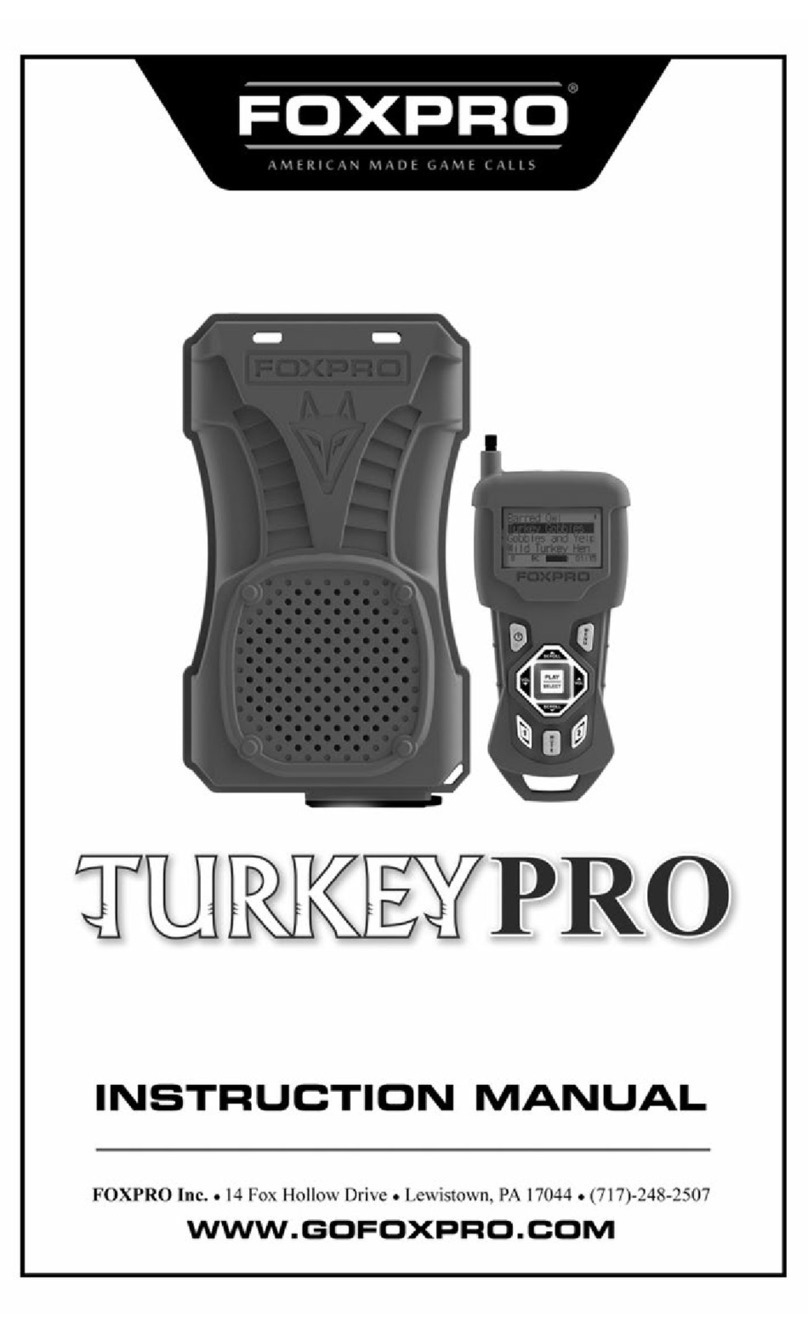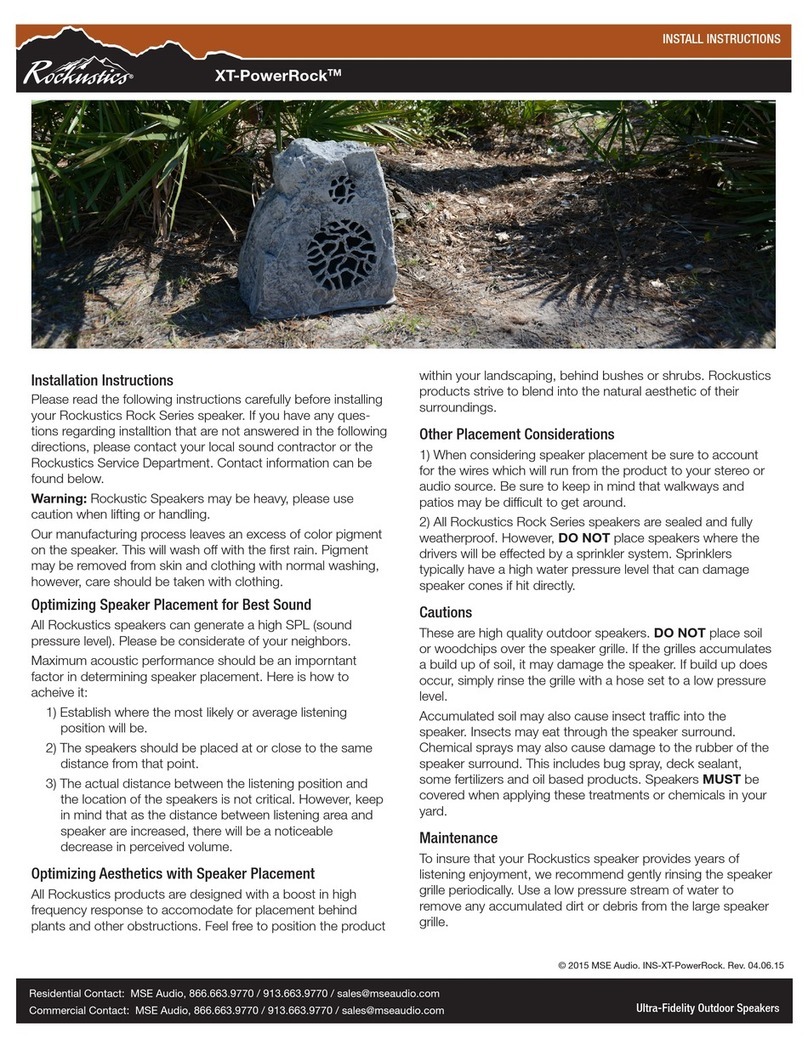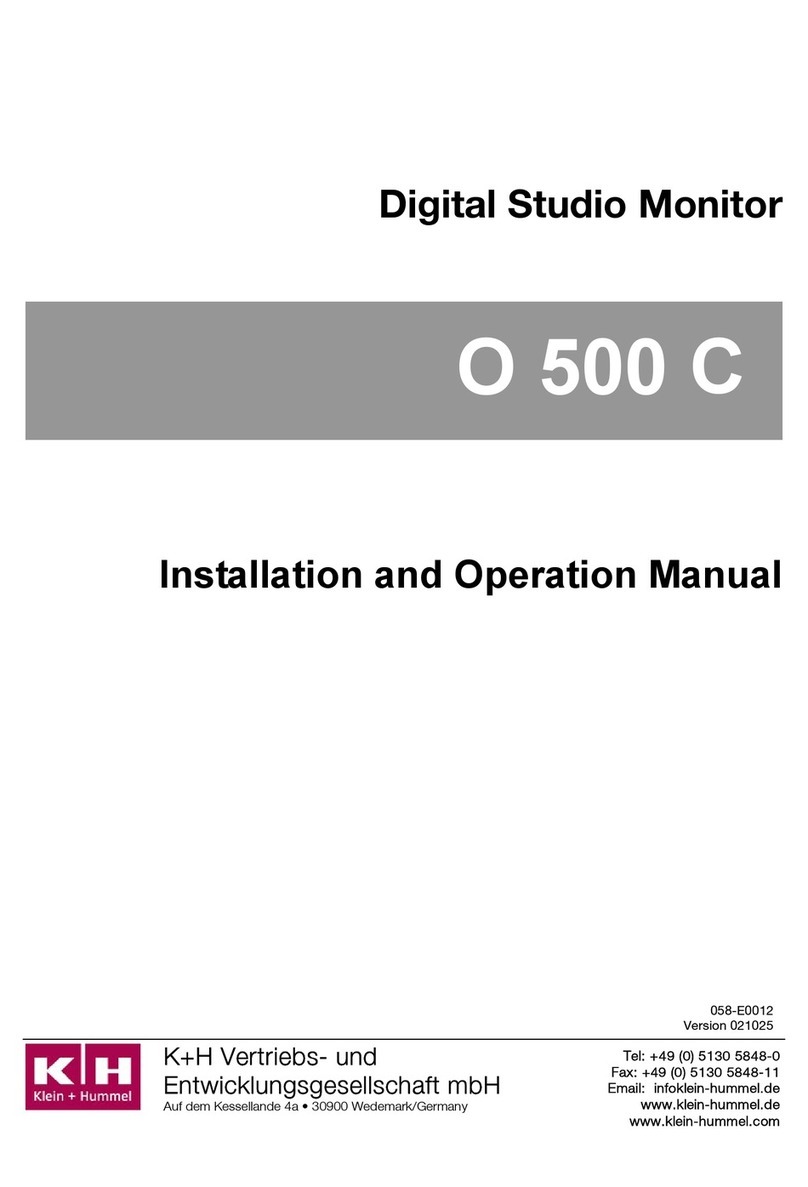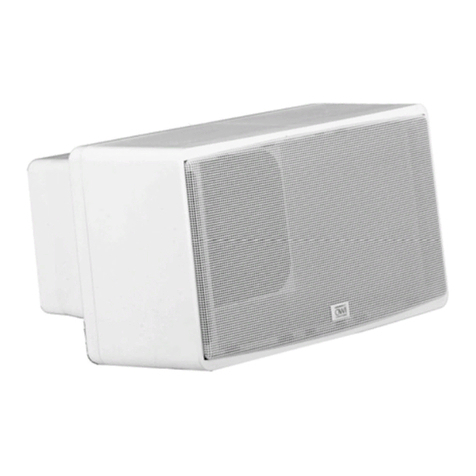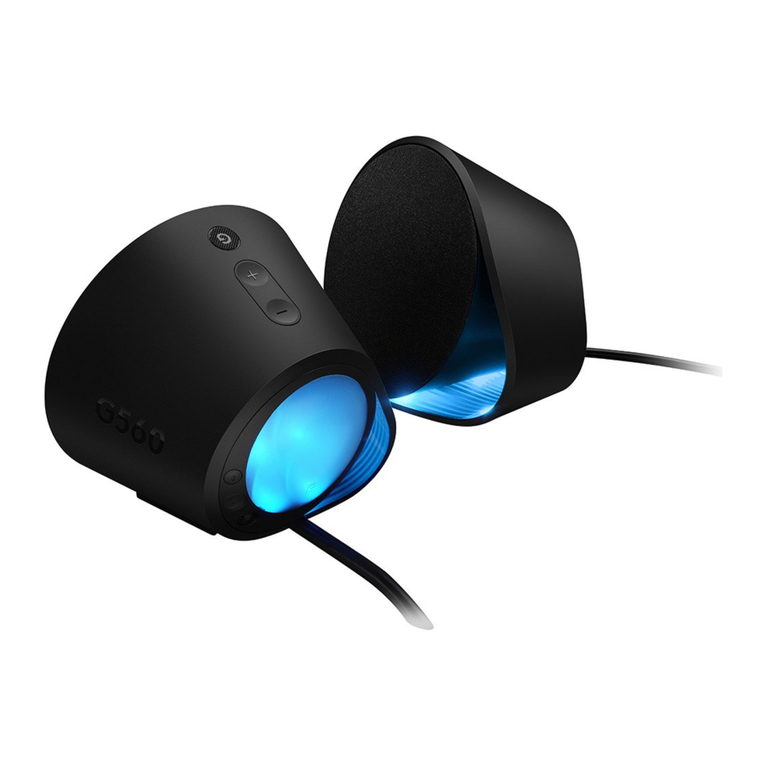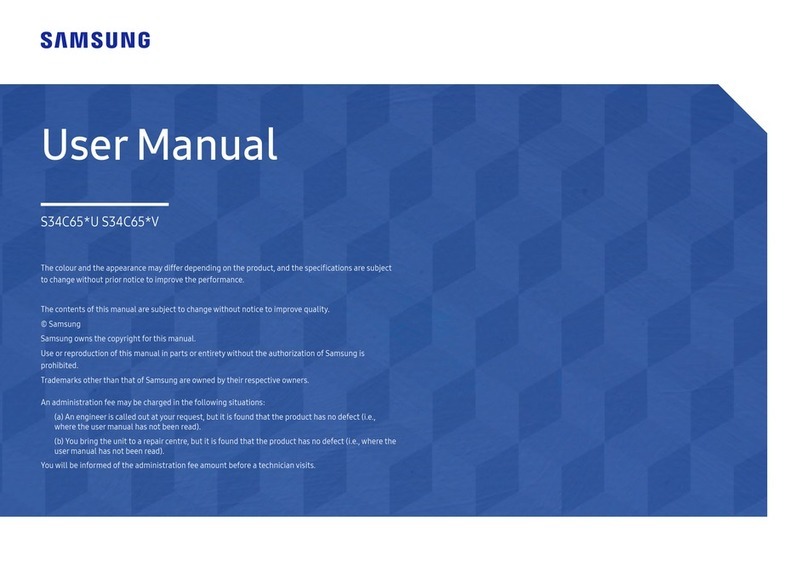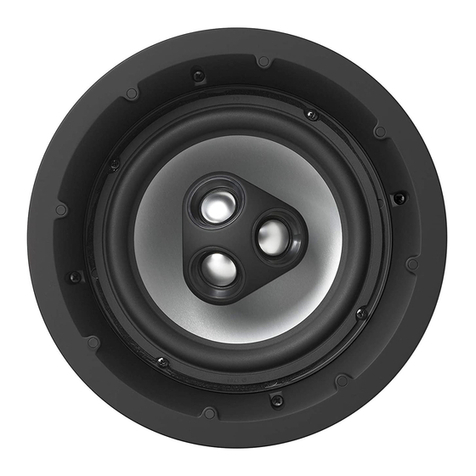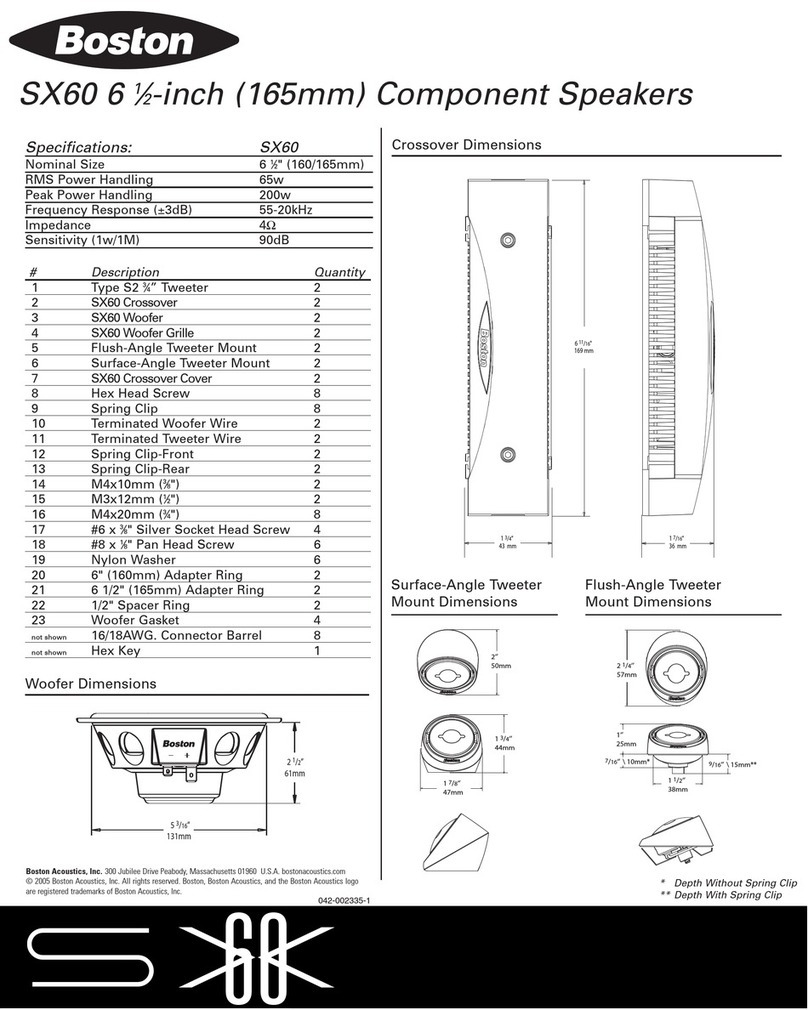Konig & Meyer Ring Lock 26737 User manual

Material
Sockelplatte: Grauguss, gepulvert, schwarz
Rohrkombination: Stahl, gepulvert, schwarz
Verstellring: Alu, eloxiert, schwarz
Gewindebolzen: Stahl, verzinkt
Teleskopschelle: Zink-Guss, gepulvert, schwarz
Griff, Spreizbacken, Buchsen: PA-6
Traglast max. 20 kg*
Gewicht 11,3 kg
Abmessungen Bodenplatte: ø 450 mm, Höhe: 1120-1820 mm
Platte: 460 x 460 x 25 mm
Zubehör
K&M-Tragetaschen: 21421 für 2 Stangen,
K&M-Tragetaschen: 26751 für 1 Sockel
K&M-Flanschbuchsen: 19580, 19654, 19656
K&M-Anschraubflansch: 24281
K&M-Adapterhülse: 21326 für Boxen mit 38 mm
Innendurchmesser (=US-Variante)
SICHERHEITSHINWEISE
Vielen Dank, dass Sie sich für dieses Produkt entschieden haben. Diese Anleitung
informiert Sie über alle wichtigen Schritte bei Aufbau und Handhabung. Wir empfehlen,
sie auch für den späteren Gebrauch aufzubewahren.
PRÜFEN, INSTANDHALTEN, REINIGEN
AUFBAUANLEITUNG
FEHLERSUCHE (F) und
BESEITIGUNG (B)
KÖNIG & MEYER GmbH & Co. KG
Kiesweg 2, 97877 Wertheim, www.k-m.de
26737-000-55 Rev.12 03-80-832-00 3/20
A. ALLGEMEIN
A. - Tragkraft max. 20 kg*
A. - Montage und Handhabung nur durch geeignetes Personal
A. -(2 fachlich und körperlich geeignete Personen)
A. - Vor Installation prüfen, ob das Stativ, die Box (v.a. Größe
A. -und Güte der Flanschbuchse) sowie Hilfsmittel (z.B. Leitern)
A. -funktionstüchtig sind
A. - Bei Montagearbeiten Schutzhandschuhe tragen
A. - Verwendung nur im Innenbereich
A. - Auf geeigneten, d.h. ebenen und tragfähigen Untergrund achten
A. - ACHTUNG! Die Sockelplatte ist sehr schwer und stellt bei
A. - ACHTUNG! unsachgemäßer Handhabung eine Gefährdung für
A. - ACHTUNG! Personen und Sachen dar
A. BEACHTE: insbesondere bei der Montage nicht fallen lassen oder
A. BEACHTE: Gliedmaße quetschen
B. AUFBAU, BETRIEB, DEMONTAGE
B. AUFBAU: Schraubverbindung zwischen Stativrohr und
B. -Sockelplatte muss stets bis zum Anschlag angezogen sein 3.a
B. - Festigkeit dieser Verbindung ist regelmäßig zu prüfen
B. BETRIEB: Rohrkombination immer zentrisch belasten:
B. - außermittige Lasten beeinträchtigen die Standfestigkeit
B. - Rastbolzen 13 muss sich stets im Eingriff befinden
B. -und die Klemmschraube 14 angezogen sein
B. - Niemals Rastbolzen und Klemmschraube unkontrolliert lösen,
B. -d.h. das Auszugrohr muss in diesem Falle stets von einer
B. -geeigneten Person festgehalten werden 7
B. DEMONTAGE: erst Traglast vom Auszugrohr entfernen und
B. danach das Stativrohr aus der Sockelplatte herausdrehen
C. SEITENKRÄFTE
C. - Seitenkräfte sind wegen der Kippgefährdung unbedingt zu vermeiden
C. -Sie entstehen (oft unabsichtlich) durch:
C. -a. außermittigen Schwerpunkt der Traglast
C. -b. Stöße, Berührungen, Erschütterungen, Wind, unebener Boden
C. -c. den Versuch das belastete Stativ zu verschieben
C. BEACHTE: Sicherheitsabstände einhalten, Unbefugte fernhalten,
C. Falls die Wirksamkeit dieser Maßnahmen nicht garantiert werden kann,
C. (z.B. durch unkontrollierbare Nichteinhaltung des Sicherheitsabstandes)
C. sind durch den Aufsteller zusätzliche Sicherungen vorzunehmen
C. als da u.a. sind:
C. - Verankerung der Sockelplatte im Boden
C. - geeignete Erweiterung/Ausbau/Beschwerung der Sockelplatte
F: Sockelplatte kippelt auf dem Boden:
F: B: Untergrund auf Ebenheit prüfen
F: B: Filzschoner vorhanden?
F: Rohrkombination wackelt bzw. steht schief:
F: B: Festsitz der M20-Gewinde prüfen und
F: B: ggf. Rohrkombination fest eindrehen 3.a.
F: B: Rohrkombination auf Geradheit prüfen
F: B: Für ebenen Untergrund sorgen
F: Auszugrohr wackelt bzw. fährt ein unter Last:
F: B: Klemmschraube 14 anziehen
F: B: Rastbolzen 13 prüfen ob eingerastet
F: Box lässt sich schwer drehen
F: B: Box etwas anheben beim Verdrehen
F: B: Sicherungsring 4noch etwas lockern
1Gußplatte an gewünschter Stelle mit
1Filzschonern nach unten auslegen.
2Klemmschraube in Spannschelle ein-
2drehen und fest anziehen (Handkraft genügt)
3Gewinde-M20 der Rohrkombination bis zum
3Anschlag fest in die Gußplatte einschrauben.
3.a Zwischen Rohr und Platte darf sich kein
3.a Luftspalt befinden. BEACHTE: Verschraubung
3.a regelmäßig prüfen und ggf. nachziehen.
26737 Boxenstativ
»Ring Lock«
- Attraktives Stativ dank eleganter Optik bei geringem Platzbedarf
- Für Lautsprecher bis max. 20 kg*
- mit patentiertem Spreizdorn für festen spielfreien Sitz der Box
- Höhenverstellbare Stativrohrkombination
-(mit Rastbolzen u. Klemmschraube)
- Höhe min.1120 / max.1820 mm; Gusssockel ø 450 mm,
-Spreizdorn ø 35-36,5 mm; Auszug: ø 35 mm; Gewicht: 11,3 kg
TECHNISCHE DATEN / SPEZIFIKATIONEN
- Schonender Umgang mit dem Distanzrohr erhält die Teleskopierbarkeit, die Tragkraft und die Sicherheit der Installation.
- Bei Wartungsarbeiten -stets im unbelasteten Zustand- auf evtl. Gefährdungen achten (Einklemmen, Anstoßen, Kippen).
- Zur Reinigung und Pflege am besten ein leicht feuchtes Tuch und ein nicht scheuerndes Reinigungsmittel benutzen.
*Bei zentrischer Belastung, auf waagerechter Fläche und ohne Seitenkräfte (Wind, Stöße etc.)

BENUTZERHINWEISE / FUNKTIONEN
DAS BEWEGEN DER LAST
Beteiligte:
EP - Erste Person: bedient das Auszugrohr 7
EP - Erste Person: mit der Last
ZP - Zweite Person: bedient Klemmschraube 8, 14 und
ZP - Zweite Person: Rastbolzen 9, 11 der Spannschelle
Reihenfolge beim Ausfahren:
EP - 7hält Auszugrohr fest
ZP - 8lockert Klemmschraube und hält diese fest
ZP - 9zieht den Rastknopf bis sich der Rastbolzen
ZP - 3nicht mehr im Eingriff befindet
EP - 10 stemmt das Auszugrohr mitsamt Lautsprecher
EP - 10 in die gewünschte Höhe;
EP - 10 BEACHTE:
EP - 10 Zum einfachen Auffinden der
EP - 10 Rastloches sollte sich diese in diesem Moment
EP - 10 kurz über der Spannschelle befinden
ZP - 11 lässt den Rastknopf los, damit der Bolzen in
ZP - 11 die Bohrung des Auszugrohres einrasten kann
EP - 12 lässt Auszugrohr langsam ab bis der
EP - 12 Rastbolzen in das Loch einrastet
EP - 13 BEACHTE: der Vorgang des Einrastens
EP - 13 ist normalerweise gut hörbar > auf jeden
EP - 13 Fall muss der Bedienknopf am Sechs-
EP - 13 kant anliegen
ZP - 14 dreht Klemmschraube fest
ZP - 14 (Handkraft genügt)
Das Einfahren der Last
Das Einfahren der Last erfolgt in
umgekehrter Reihenfolge.
WICHTIG:
Stellen Sie sicher, dass die "zweiten Person" sofort die
Klemmschraube 14 anzieht, falls das Auszugrohr von
der "erste Person" nicht sicher gehalten werden kann.
ACHTUNG!
- Unterschätzen Sie nicht das Gewicht des Lautsprechers
- Das Aufsetzen und Ausfahren des Lautsprechers muss durch fachlich
-und körperlich geeignetes Personal erfolgen
- Auszugrohr während der Höhenverstellung mit festem Griff halten
-und stets mit Rastbolzen sichern
LAUTSPRECHER AM STATIV BEFESTIGEN
4Spreizdorn-Spannring nach rechts drehen (Richtung OPEN),
4um den kleinsten Durchmesser einzustellen
5Lautsprecher auf Auszugrohr setzen (direkt oder in K&M-Adapter)
6Spannring jetzt nach links drehen (Richtung CLOSE) bis die
6Spreizbacken in der Buchse fest anliegen
RICHTUNG DES LAUTSPRECHERS VERÄNDERN
- Spannring 4öffnen (Richtung OPEN) und Box in die
-gewünschte Richtung drehen
- Spannring 6wieder fest anziehen (Richtung CLOSE)

Material
Base plate: Gray die cast, powder coated black
Tube combination: Steel, powder coated black
Adjustment ring: Aluminum anodized, black
Threaded bolt: Steel, galvanized
Telescope bracket: Zinc Die-cast, powder
coated black
Handle, mandrel, adapter: PA-6
Load max. 20 kg*
Weight 11.3 kg
Dimensions
Floor base plate ø 450 mm,
Height: 1120-1820 mm
Plate: 460 x 460 x 25 mm
Accessories
K&M Carrying case: 21421 for 2 rods,
K&M Carrying case: 26751 for 1 base
K&M-Flange adapter: 19580, 19654, 19656
K&M-Screw-on flange: 24281
K&M-Adapter Sleeve: 21326 for loudspeakers
with 38 mm internal diameter (=US-Variant)
SAFETY NOTES
Thank you for choosing this product. The instructions provide directions to all of the
important set up and handling steps. We recommend you keep these instructions for
future reference.
CHECK, MAINTENANCE, CLEANING
SET UP INSTRUCTIONS
FAULT-FINDING (F) and
REPAIR (R)
KÖNIG & MEYER GmbH & Co. KG
Kiesweg 2, 97877 Wertheim, www.k-m.de
26737-000-55 Rev.12 03-80-832-00 3/20
A. GENERAL
A. - Load bearing weight: max 20 kg*
A. - Assembly and handling only by qualified technicians
A. -(we recommend 2 technicians that are physically fit)
A. - Prior to installation check if the stand, loudspeaker (particularly the size
A. -and quality of the flange adapter) as well as ensuring that the aids
A. -(e.g. ladders) are in working order
A. - Wear protective gloves during assembly
A. - Only to be used indoors
A. - Be sure that the surface will bear the load and is suitable and level
A. - ATTENTION! The base plate is very heaving and improper use
A. - ATTENTION! can result in risk to individuals and objects
A. NOTE: In particular during assembly do not drop or crush limbs
B. SETUP, OPERATION, DISASSEMBLY
B. SETUP The screw connection between the stand tube and
B. -the base plate must be screwed in as far as it will go 3.a
B. - Routinely check that the screws are properly tightened
B. OPERATION: The weight tube combination must be centered:
B. - if the weight is not centered - this has a negative affect on stability
B. - Locking pin 13 must be locked into place
B. -and the clamping screw 14 must be tightened
B. - Never loosen the locking pin and the clamp screw
B. -without having someone hold the
B. -heavy objects on the stand 7
B. DISASSEMBLY: first remove the objects from the extension tube
B. then unscrew the stand tube from the base plate
C. LATERAL FORCES
C. - Lateral forces are to be avoided due to the risk of it falling over
C. -These lateral forces are created (often unintentionally) as follows:
C. -a. the load bearing weight is not centered
C. -b. bump and/or brushing into, vibration, wind, uneven surface
C. -c. the attempt to move the loaded stand
C. NOTE: Maintain safety distance, keep unauthorized persons away
C. Should the effectiveness of the measures not be guaranteed,
C. (.g. through not keeping the safety distance and the distance is not
C. routinely checked by personnel) the technicians should secure the object
C. with the following additional steps these include among others:
C. - anchor the base plate to the floor
C. - suitable extension/expansion/weighting down of the base plate
F: The base plate rocks back and forth on the floor:
F: R: Check if the surface is even
F: R: Are the felt protectors there?
F: The tube combination is not sturdy i.e. is
F: leaning to one side:
F: R: Check to ensure that the M-20 bolt is tight,
F: R: Securely screw in the tube combination 3.a.
F: R: Check to ensure the tube combination is
F: R: straight
F: R: Ensure that the surface is even
F: Distance rod is not stable / retracts:
F: R: Tighten the clamping screw 14
F: R: Check locking pin 13 to see if it is clicked
into place
F: It is difficult to turn the loudspeaker
F: R: Pick up the loudspeaker a bit when turning
F: R: the loud speaker
F: R: Loosen the locking pin 4somewhat
1Base plate with feet are to be placed
1feet down in the desired position.
2Screw the clamp screw into clamping
2bracket and tighten (manual strength is
2enough).
3Threaded connector M20 of the tube
3combination is to be screwed into the
3baseplate as far as it will go.
3.a Ensure that a space is not left between
3.a the tube and the plate. NOTE: Regularly
3.a check and tighten the screws, if needed.
26737 Speaker stand
»Ring Lock«
- Attractive stand thanks to its elegant design for tight spaces
- For loudspeakers up to max. 20 kg*
- With a patented mandrel for secure and tight fitting speakers.
- Height adjustable stand tube combinatio
-(with locking pin and clamp screw)
- Height min. 1120 / max.1820 mm; Heavy cast iron base ø 450 mm,
-Mandrel ø 35-36.5 mm; Extension: ø 35 mm; Weight: 11.3 kg
TECHNICAL DATA
- Careful use of the stand maintains the use of the telescope and the load bearing functionality of the stand, as well as the
-safety of the installation.
- Perform workstation maintenance only without the speakers attached and watch for possible risks (pinched hands/fingers,
-impact or the stand falls over).
- To care for the product use a damp cloth and a non-abrasive cleaning agent.
* With centric loading, on a horizontal surface and without lateral forces (wind, shocks etc.)

USAGE NOTES / FUNCTIONS
MOVING THE SPEAKER (LOAD)
Technicians:
FP - first person: operates the distance rod 7
FP - first person: with the weight
SP - second person: operates the clamping screw 8,14
SP - second person: and locking pin 9,11 of the clamping bracket
Order when extending the rod:
FP - 7holds the distance rod
SP - 8loosens the clamp screw and holds it
SP - 9pulls the locking knob until the locking pin
SP - 3is no longer in the locked position
FP - 10 lifts the distance rod and loudspeaker
FP - 10 to the desired height;
FP - 10 TIP:
FP - 10 positioned it just above
FP - 10 the clamping bracket
SP - 11 lets go of the locking knob,
SP - 11 so that the pin can click into the distance rod
FP - 12 slowly lowers the distance rod
FP - 12 so that the locking pin locks into the hole
FP - 13 NOTE: this is in the proper positing
FP - 13 when the clicking sound is heard
FP - 13 the operating button must be in the
FP - 13 hexagonal hole
SP - 14 loosens the clamp screw
ZP - 14 (manual strength is enough)
RETRACTING THE WEIGHT
When retracting the weight the
reverse order applies.
IMPORTANT:
Ensure that second person tightens the
clamping screw 14 immediately in the
event that the first person is not able to hold
the distance rod.
ATTENTION!
- Do not underestimate the weight of the loudspeakers
- Placement and extension of the loudspeakers must be carried out by
-physically fit technicians
- Firmly grasp the distance rod when adjusting the height to the desired
-position and lock the locking pin
ATTACH LOUDSPEAKER TO THE STAND
4Turn the Mandrel Locking Ring to the right (Direction OPEN),
4to be able to set the system to the smallest diameter
5Place the loudspeaker on the extension rod (directly or with a K&M-Adapter)
6Now turn the locking ring to the left (Direction CLOSE) until the
6mandrels lock into place
CHANGE THE DIRECTION OF THE LOUDSPEAKERS
- Open locking ring 4(Direction OPEN),
-and turn the loudspeaker in the desired direction
- Tighten locking ring 6(Direction CLOSE)
Table of contents
Languages:
Other Konig & Meyer Speakers manuals

Konig & Meyer
Konig & Meyer 26734 User manual
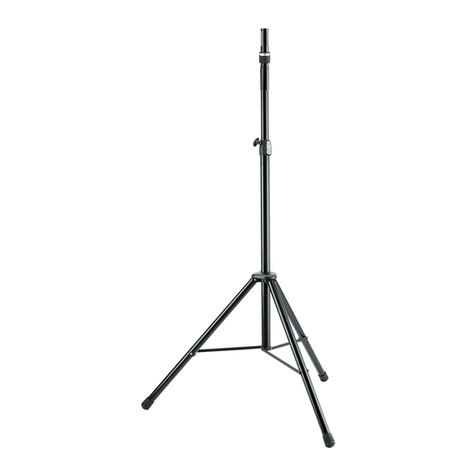
Konig & Meyer
Konig & Meyer Ring Lock User manual
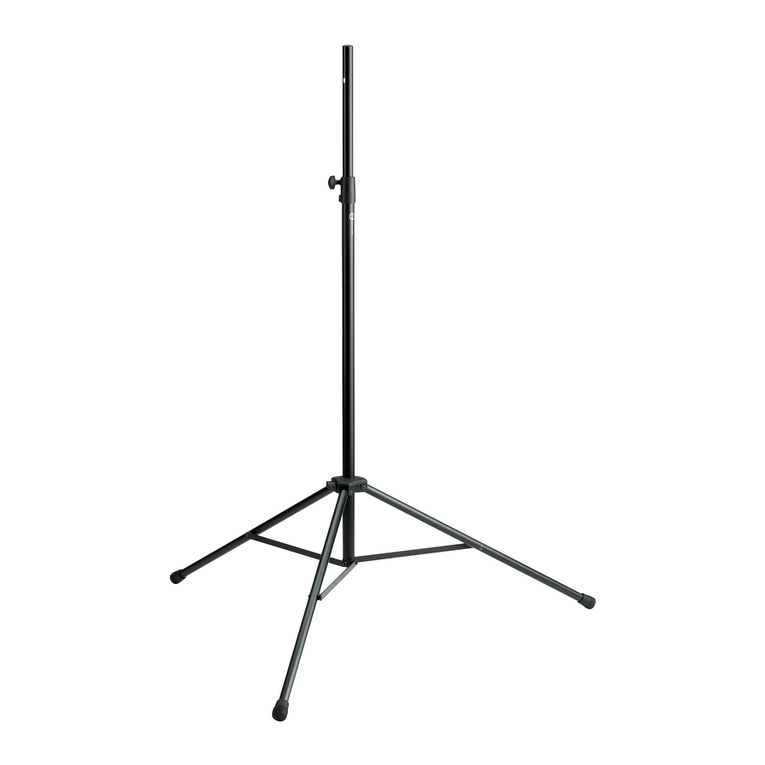
Konig & Meyer
Konig & Meyer 21420 User manual
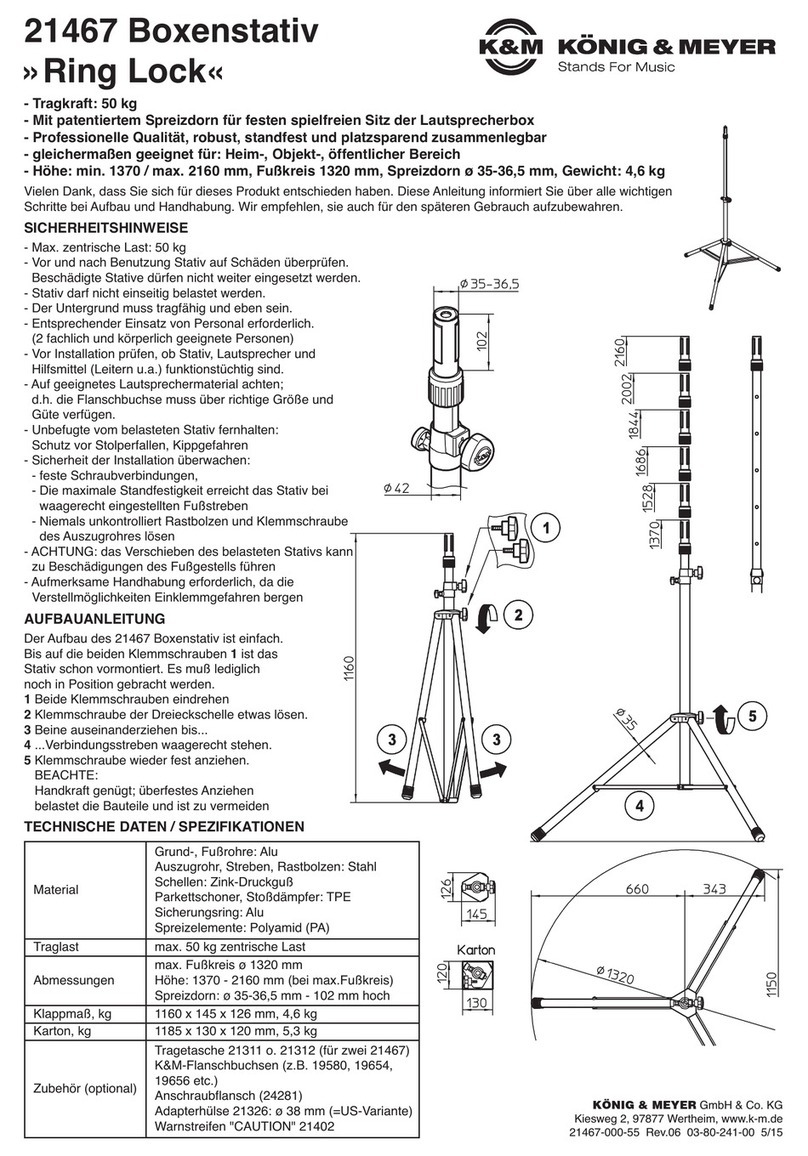
Konig & Meyer
Konig & Meyer Ring Lock 21467 User manual
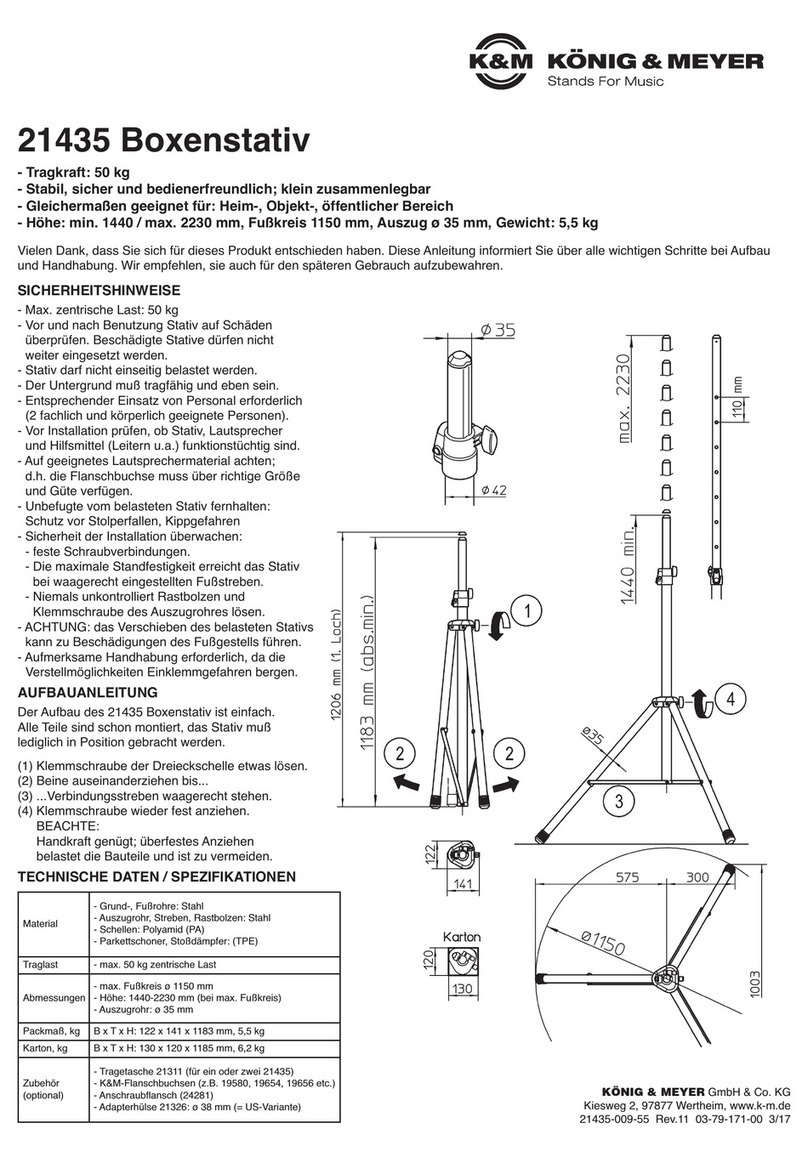
Konig & Meyer
Konig & Meyer 21435 User manual
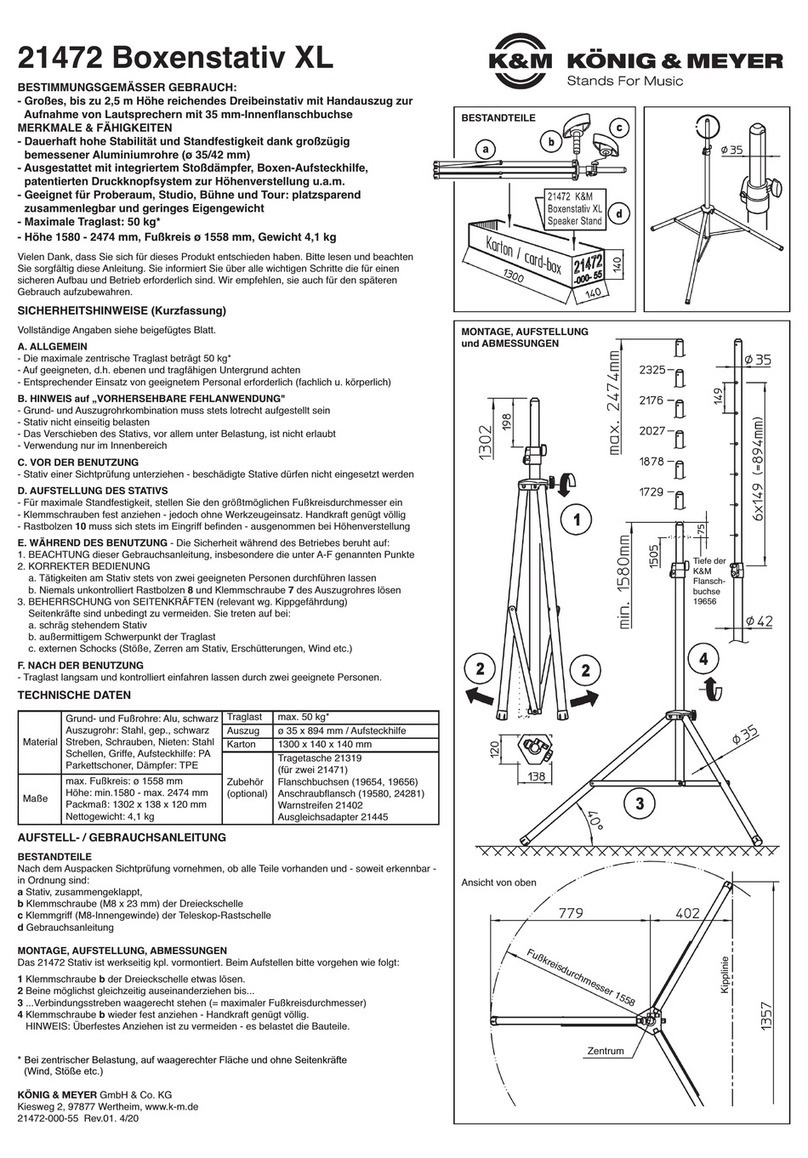
Konig & Meyer
Konig & Meyer Speaker stand XL 21472 User manual
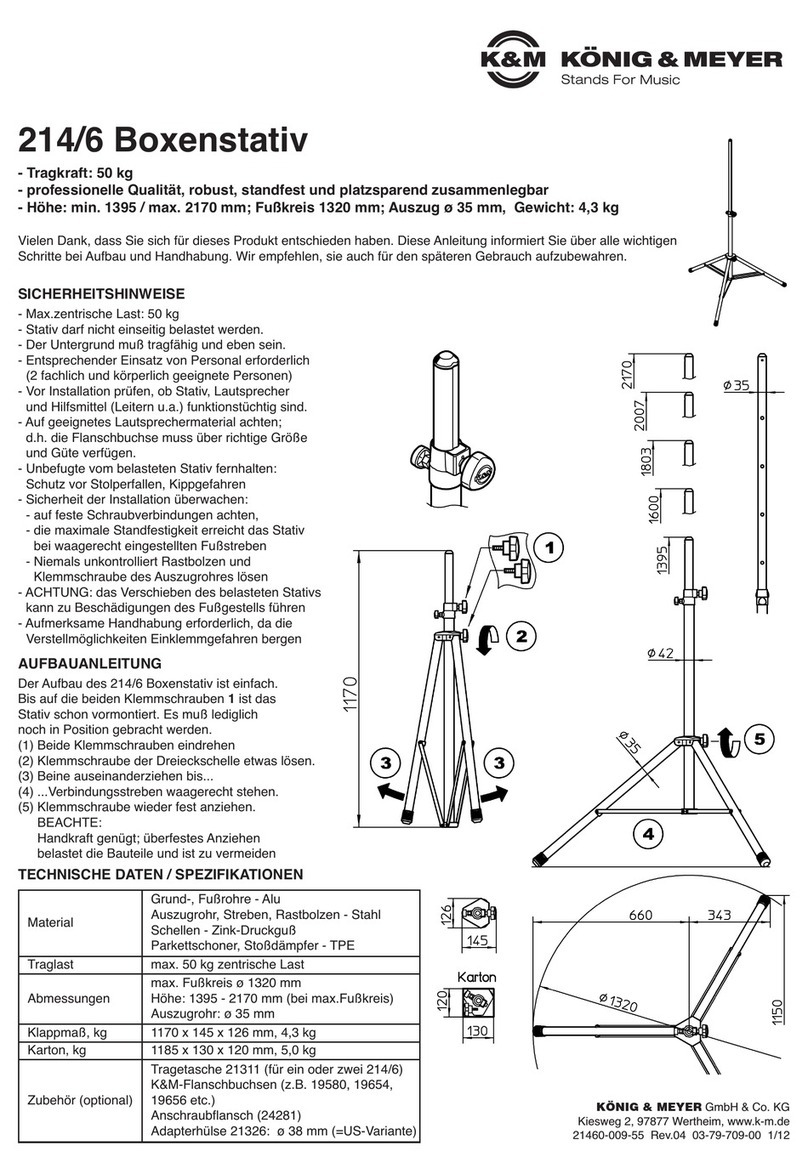
Konig & Meyer
Konig & Meyer 214/6 User manual
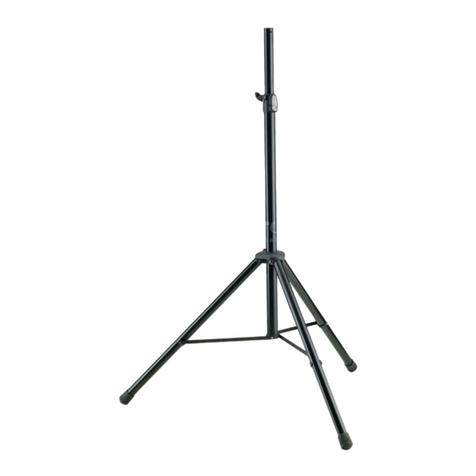
Konig & Meyer
Konig & Meyer 21435 User manual
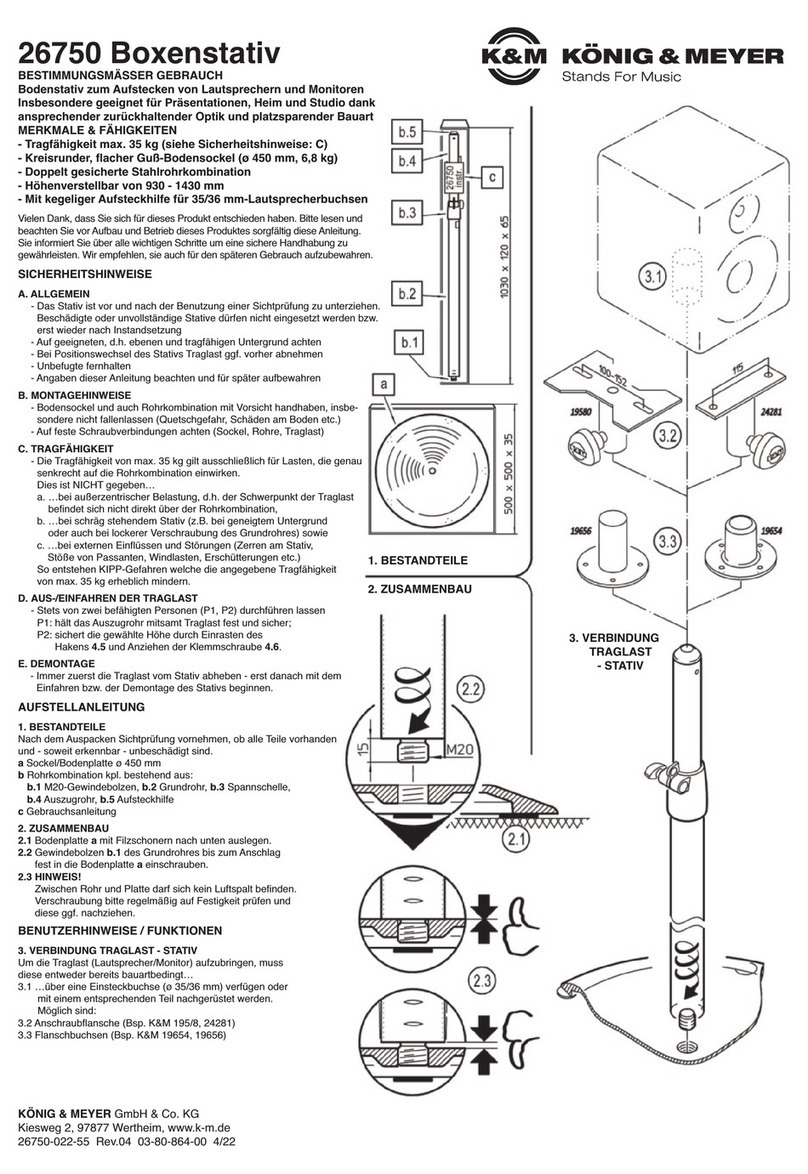
Konig & Meyer
Konig & Meyer 26750 User manual
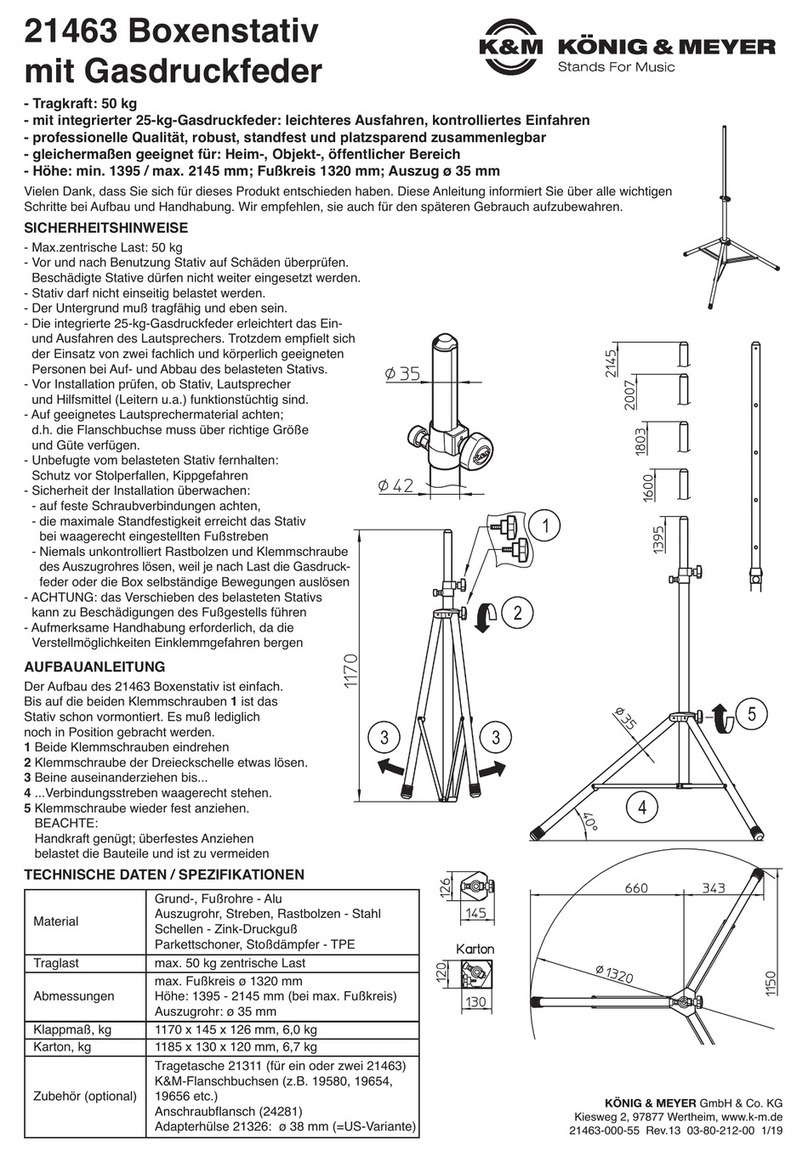
Konig & Meyer
Konig & Meyer 21463 User manual


